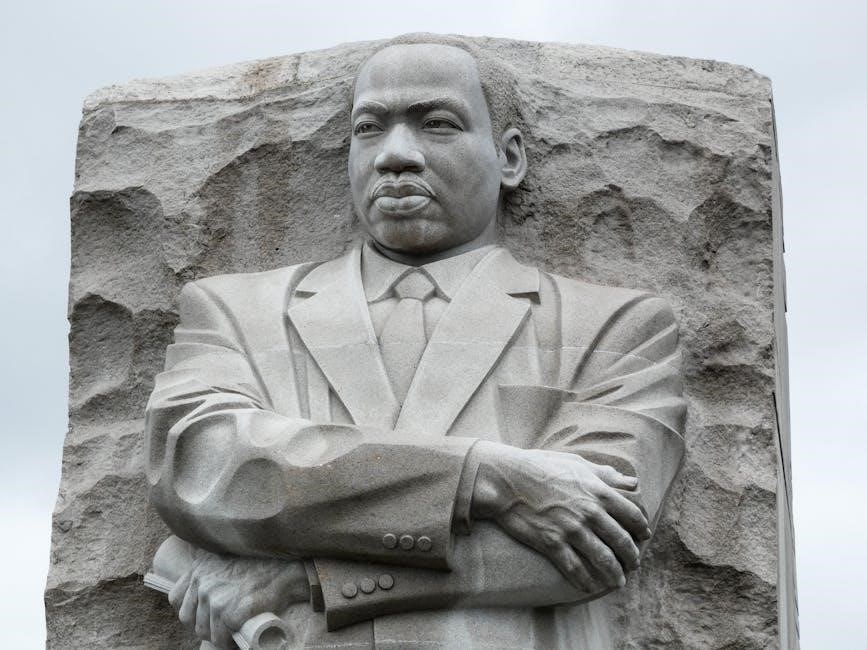martin luther 95 theses summary pdf
Martin Luther’s 95 Theses, published in 1517, criticized Catholic Church practices like indulgences, sparking the Protestant Reformation․ This document remains a cornerstone of religious and historical study․
Overview of Martin Luther and the 95 Theses
Martin Luther, a German monk and theologian, became a pivotal figure in Christian history when he published the 95 Theses in 1517․ This document, written in Latin, criticized the Catholic Church’s practice of selling indulgences, which Luther believed undermined the doctrine of repentance and faith․ By nailing the theses to the door of Wittenberg’s Castle Church, Luther aimed to provoke a theological debate․ However, the widespread circulation of the document, facilitated by the printing press, transformed it into a catalyst for the Protestant Reformation․ Luther’s arguments centered on the idea that salvation comes through faith and grace, not through purchased pardons․ His bold challenge to Church authority reshaped Christianity and left a lasting legacy in European theology and society․
Significance of the 95 Theses in Church History
The 95 Theses marked a turning point in church history, challenging the Catholic Church’s authority and sparking the Protestant Reformation․ By questioning indulgences, Luther highlighted broader issues within the Church, such as corruption and the sale of spiritual benefits․ His critique resonated across Europe, leading to widespread theological and social changes․ The document’s emphasis on individual faith and direct access to Scripture laid the groundwork for Protestant theology․ Its impact extended beyond religion, influencing political and cultural landscapes․ Today, the 95 Theses are celebrated as a symbol of reform and a pivotal moment in the evolution of Christianity, shaping both the Church and Western society for centuries to come․

Background
Martin Luther, a German monk and priest, opposed certain Catholic Church practices in the early 16th century, initiating the Protestant Reformation with his 95 Theses․
The Catholic Church in the Early 16th Century
The Catholic Church in the early 16th century held immense power and influence across Europe, with the Pope as its central authority․ Corruption, however, had seeped into its hierarchy, and practices like the sale of indulgences became widespread․ This system, where people could buy forgiveness for sins, was heavily criticized by reformers․ The Church’s wealth and political entanglements further fueled discontent among both clergy and laity․ Simultaneously, the rise of humanism and theological debates challenged traditional doctrines․ These issues created a fertile ground for dissent, setting the stage for Martin Luther’s 95 Theses, which would ignite the Protestant Reformation and forever alter the religious landscape of Europe․

The Practice of Indulgences

The practice of indulgences in the early 16th century allowed individuals to reduce their time in purgatory by purchasing certificates․ The Catholic Church taught that indulgences could remit the temporal punishment for sins, either for the living or the dead․ Preachers often emphasized the immediate forgiveness and spiritual benefits these certificates provided․ This system became a lucrative source of income for the Church, as people sought to ensure their loved ones’ salvation․ Critics, including Martin Luther, argued that this practice undermined genuine repentance and exploited the faithful․ Luther’s 95 Theses primarily targeted this abuse, questioning the Pope’s authority to grant such pardons and challenging the idea that salvation could be bought․
Martin Luther’s Early Life and Theological Concerns
Martin Luther was born in 1483 in Eisleben, Germany, to a devout Catholic family․ His father, a miner, encouraged Luther’s education, leading him to study law․ However, after a life-altering experience during a thunderstorm, Luther became an Augustinian monk in 1505․ His theological concerns grew as he grappled with the concept of God’s justice and human sinfulness․ Through intense study of Scripture, Luther developed a deep understanding of faith and grace, which later challenged the Catholic Church’s teachings․ His personal struggles and scriptural insights laid the groundwork for his critiques of Church practices, particularly indulgences, and his eventual role in the Protestant Reformation․

Publication and Distribution
Martin Luther posted his 95 Theses on October 31, 1517, in Wittenberg․ The document was swiftly printed and distributed, spreading his ideas across Europe and fueling the Protestant Reformation․
The Date and Location of the 95 Theses
Martin Luther published his groundbreaking 95 Theses on October 31, 1517․ This significant event took place in Wittenberg, Germany, where Luther, a university professor and monk, resided․ He nailed the document to the door of the Castle Church, a common practice for announcing academic debates․ The act was both symbolic and strategic, as it ensured visibility within the scholarly community and the broader public․ Wittenberg, a hub of intellectual and religious activity, provided the ideal setting for Luther’s critique of indulgences to gain traction and spread rapidly across Europe․
How the 95 Theses Were Disseminated
The 95 Theses were initially nailed to the door of Wittenberg’s Castle Church, a common practice for announcing debates․ However, their spread was accelerated by printing․ The Latin text was widely circulated, and soon, a German translation appeared, broadening accessibility․ The theses were printed in cities like Leipzig and Nuremberg, ensuring rapid dissemination․ The use of the printing press, a relatively new technology, allowed Luther’s ideas to reach a vast audience․ The document’s popularity was further fueled by its controversial nature, sparking debates and discussions across Europe․ This widespread circulation laid the foundation for the Protestant Reformation, as Luther’s critique of indulgences gained unprecedented visibility and influence․

Key Themes and Arguments
Martin Luther’s 95 Theses criticized indulgences, challenged papal authority, and emphasized faith and grace as the true path to salvation, reshaping religious thought in Europe․
Criticism of Indulgences
Martin Luther’s 95 Theses primarily targeted the Catholic Church’s practice of selling indulgences, which he viewed as corrupt and contrary to biblical teachings․ He argued that indulgences, promoted as a means to reduce punishment for sins, undermined genuine repentance and faith․ Luther criticized the Church for exploiting people’s fear of purgatory to generate income, calling it a form of spiritual exploitation․ He emphasized that true forgiveness could only come from God, not from papal decrees or monetary transactions․ Luther’s critique challenged the Church’s authority and exposed the commercialization of spirituality, sparking widespread debate and contributing to the Reformation movement․
Challenges to Papal Authority
Martin Luther’s 95 Theses challenged the authority of the Pope and the Catholic Church, questioning the notion that the papacy held exclusive power to grant forgiveness․ Luther argued that the Pope could not forgive sins or reduce punishment in purgatory, as such power belonged to God alone․ He rejected the idea that indulgences, backed by papal decrees, could erase guilt or penalties for sin․ Luther’s critique extended to the hierarchical structure of the Church, asserting that spiritual authority should be derived from Scripture, not papal rulings․ This bold challenge to papal authority sparked debates about the Church’s legitimacy and its interpretation of divine law, further fueling the Reformation movement․
The Role of Faith and Grace
Martin Luther’s 95 Theses emphasized the central role of faith and grace in achieving salvation, challenging the Church’s emphasis on indulgences․ Luther argued that true repentance and forgiveness come from God’s grace, not from purchasing indulgences․ He asserted that faith alone (sola fide) was the means to salvation, rejecting the idea that good works or payments could earn divine favor․ Luther’s Theses highlighted the importance of individual spiritual connection with God, bypassing the mediation of the Church․ This theological stance redefined the relationship between believers and God, promoting a more personal and direct approach to spirituality, which became a cornerstone of Protestant theology․

Reaction and Impact
The Catholic Church condemned Luther’s views, leading to his excommunication․ His ideas sparked widespread debate, fueling the Protestant Reformation and reshaping European theology and society․
The Catholic Church’s Response
The Catholic Church swiftly condemned Luther’s 95 Theses, viewing them as a direct challenge to its authority․ Pope Leo X issued the papal bull Exsurge Domine in 1520, denouncing Luther’s ideas as heretical and demanding he retract his statements․ When Luther refused, he was excommunicated through the bull Decet Romanum Pontificem in 1521․ The Church’s response was firm, aiming to maintain its doctrinal integrity and suppress dissent․ This reaction not only solidified Luther’s break with Rome but also galvanized support for his cause among those critical of Church practices․ The confrontation marked the beginning of a theological and political conflict that would reshape Europe․
The Spread of Luther’s Ideas
Luther’s 95 Theses gained rapid traction due to the printing press, enabling widespread distribution across Europe․ His use of German language and clear arguments made his critiques accessible to the masses․ Support from German princes and the emotional resonance of his ideas among those disillusioned with Church practices further accelerated their spread․ Luther’s teachings were debated in universities and towns, sparking reform movements; The dissemination of his ideas was also fueled by his subsequent writings, such as To the Christian Nobility of the German Nation and Martin Luther’s 95 Theses initiated the Protestant Reformation, reshaping Christianity and emphasizing salvation through faith․ His ideas influenced theology, culture, and society, leaving a lasting global impact․ Martin Luther’s 95 Theses became the catalyst for the Protestant Reformation, a movement that challenged Catholic Church authority and reshaped Christianity․ By criticizing indulgences and emphasizing salvation through faith alone, Luther sparked widespread theological and societal change․ His ideas spread rapidly across Europe, inspiring reformers like Calvin and Zwingli․ The Reformation led to the emergence of Protestant denominations, altering religious practices and fostering a culture of individual interpretation of scripture․ This period also prompted the Catholic Church to respond with its own reforms during the Counter-Reformation․ Luther’s bold stance against established traditions not only transformed theology but also influenced art, politics, and education, leaving a lasting legacy in European history and global Christianity․ Martin Luther’s 95 Theses profoundly influenced European society and theology, reshaping religious, cultural, and political landscapes․ Theologically, Luther’s emphasis on justification by faith alone rejected traditional Catholic doctrines, promoting individual spirituality․ Societally, his ideas challenged hierarchical structures and empowered laypeople, fostering literacy and education through vernacular Bible translations․ Politically, the Reformation divided Europe, sparking conflicts and nation-building as rulers aligned with Protestant or Catholic factions․ Theological debates flourished, leading to diverse Protestant movements and the Catholic Counter-Reformation․ Luther’s critique of indulgences also exposed Church corruption, prompting reforms․ His legacy endures as a pivotal figure in shaping modern Christianity and democratic ideals, highlighting the intersections of faith, culture, and governance in Europe․ Martin Luther’s 95 Theses remain a cornerstone of religious history, sparking the Protestant Reformation and shaping modern Christianity with their enduring theological and cultural impact․ Martin Luther’s 95 Theses, published in 1517, are a cornerstone of the Protestant Reformation․ They challenged the Catholic Church’s practice of selling indulgences, which Luther believed undermined true repentance and faith․ The document emphasized the importance of spiritual salvation through grace and faith rather than material payments․ By questioning papal authority, Luther sparked widespread theological and cultural changes across Europe․ The theses’ dissemination through printing technology accelerated their impact, leading to a broader critique of Church practices and contributing to the fracturing of Western Christianity․ Their legacy endures as a pivotal moment in religious and historical transformation, shaping modern Christianity and its theological foundations․ The 95 Theses remain a vital document for understanding the roots of Protestantism and its enduring influence on society and theology․ Martin Luther’s 95 Theses marked a pivotal moment in Christian history, challenging Church practices and sparking the Protestant Reformation․ His critique of indulgences and emphasis on salvation through faith and grace reshaped theology․ Luther’s bold stand against papal authority inspired widespread reform, fostering religious diversity and intellectual freedom․ His legacy extends beyond theology, influencing European society, education, and politics․ As a reformer, Luther’s contributions remain foundational to Protestantism, emphasizing individual conscience and Scripture’s authority․ His ideas continue to inspire reflection on faith, justice, and the Church’s role in society, ensuring his impact endures as a transformative figure in Christian history and global culture․ For a PDF summary of the 95 Theses, visit academic or religious websites like Luther Seminary or Reformation Day resources; Recommended reading includes works by John Dillenberger and K․ Stjerna for deeper insights․ To access a PDF summary of Martin Luther’s 95 Theses, visit reputable academic or religious websites such as Luther Seminary or Reformation Day resources․ These platforms offer free downloadable versions of the document, providing a concise overview of Luther’s arguments against indulgences and his theological perspectives․ Additionally, historical societies and universities with theology departments often host PDFs of the 95 Theses for educational purposes․ Platforms like Google Books or JSTOR may also have accessible versions․ Ensure the source is credible to guarantee the accuracy and completeness of the summary․ This resource is ideal for students, researchers, or anyone seeking a clear understanding of Luther’s seminal work․ For a deeper understanding of Martin Luther’s 95 Theses, consider reading “Martin Luther: Selections from His Writings”, edited by John Dillenberger, which provides key excerpts and context․ Additionally, Luther’s “On the Freedom of a Christian” and “To the Christian Nobility of the German Nation” offer insights into his theological views․ A booklet containing the 95 Theses, along with his letter to Archbishop Albert of Mainz and “Explanations of the Ninety-Five Theses”, is highly recommended for a comprehensive analysis․ These works, available in PDF formats through academic and theological sources, provide a detailed exploration of Luther’s arguments and their historical significance․
Legacy and Influence
The Protestant Reformation
Impact on European Society and Theology

Final Thoughts on Luther’s Contribution

Additional Resources
Where to Find a PDF Summary of the 95 Theses
Recommended Reading for Further Study


